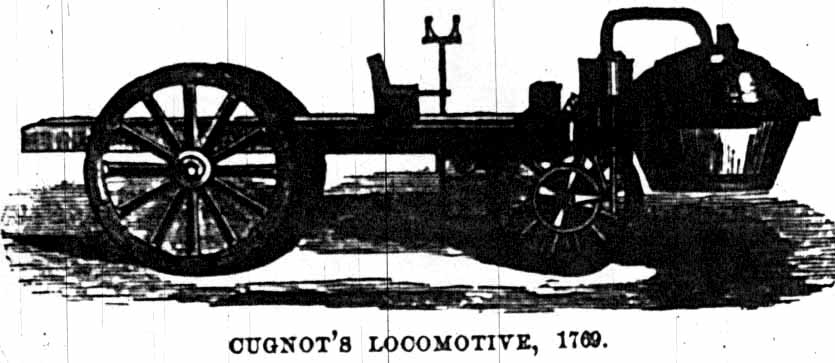
| History of the First Locomotives in America Chapter 5 First Steam Carriage |

| History of the First Locomotives in America Chapter 5 First Steam Carriage |
In 1784 William Symington conceived the idea of steam being applied to propelling carriages, and in 1786 made a working model, but soon gave it up, and nothing was ever after heard of the project.
The first English model of a steam-carriage was made in 1784, by William Murdoch; this model was based upon the principle of the high pressure, and ran on three wheels (for common roads, of course). It worked to admiration, but nothing further was ever done to bring the idea into a more practical form.
A few years after, Thomas Allen, of London, published the plan of a newly invented machine for carrying goods, without the use of horses, and by the use of steam alone for the motive pouter. His plan was to have cogged wheels to run upon cogged rails. The plan was all that was ever brought out.
In 1801 Oliver Evans, of Philadelphia, a millwright, who had entertained the idea, as early as 1772, of propelling wagons by the action of high steam, was employed by the corporation of that city to construct a dredging-machine. The experiment was of a most remarkable character. The machine was, as you may term it, an amphibious affair. He built both the vessel and the machine at his works, a mile and a half from the water. The whole weighing 42,000 lids., it was mounted upon wheels, to which motion was given by the engine and moved without any further aid from the shop to the river. After the machine was in its proper element, a wheel was then fused to the stern of the vessel, and the engine being again set in motion, she was conveyed to her designed position. Here is the first propeller. As late as the year 1800, wooden or tram roads were general in all the coal and mining districts-in England, using horse- power for the means of transportation of their coal or ore from the mines to the point of shipment.
The first idea and proposition to introduce the railroad, imperfect as it then was, for the transportation of goods and for commercial purposes generally, and to be used as a highway between one city and another, as at the present day, was made before the Literary and Philosophical Society of Newcastle, England, by Mr. Thomas, of Denton, on the 11th February, 1800. The same idea was taken hold of in 180S, by a Mr. Edge worth, who urged the same plan for the transit of passengers. He urges that stage-coaches might be made to go at six miles an hour, and post-coaches and gentlemen's travellingcarriages at eight miles an hour, with one horse alone. He also suggested that small stationary engines placed from distance to distance might be made, and by the use of endless chains draw the carriages, at a great diminution of horse-power.
These ideas of Mr. Thomas were followed by a recommendation from a Dr. Anderson, of Edinburgh, a friend and co-laborer with Watt in his experiments upon the improvements in steam-engines. The doctor dilated upon the subject with great warmth and enthusiasm. So apparently extravagant were his views upon this his favorite topic considered, that many of his friends thought his mind had become affected. " If," said he, " we can diminish only one single farthing in the cost of transportation and personal intercommunication, and you at once widen the circle of intercourse, you form, as it were, a new creation—not only of stone and earth, of trees and plants, but of men also; and, what is of far greater consequence, you promote in- dustry, happiness, and joy. The cost of all human con- sumption would be reduced, the facilities of agriculture promoted, time and distance would be almost annihi- lated; the country would be brought nearer to the town; the number of horses to carry on traffic would be diminished; mines and manufactories would appear in neighborhoods hitherto considered almost isolated by distance; villages, towns, and even cities, would spring up all through the country; and spots now as the grave would be enlivened with the busy hum of human voices, the sound of the hammer, and the clatter of machinery; the whole country would be, as it were, revolutionized with life and activity, and a general prosperity would be the result of this mighty auxiliary to trade and commerce throughout the land." How perfectly true were these arguments of Anderson, and how his predictions have been verified even in Our own State ! What else could have developed the boundless wealth of our mountain-regions but the introduction of the railroad system and its powerful auxiliary the locomotive, by which means their hitherto inaccessible fastness have been penetrated, and access thereto made comparatively easy; while their vast resources of wealth in lumber, coal, minerals, and oil, have been brought nearer to a market, and, but for this system of transportation, they would to this day have been locked up in impenetrable mystery in the deep recesses of the mountains.